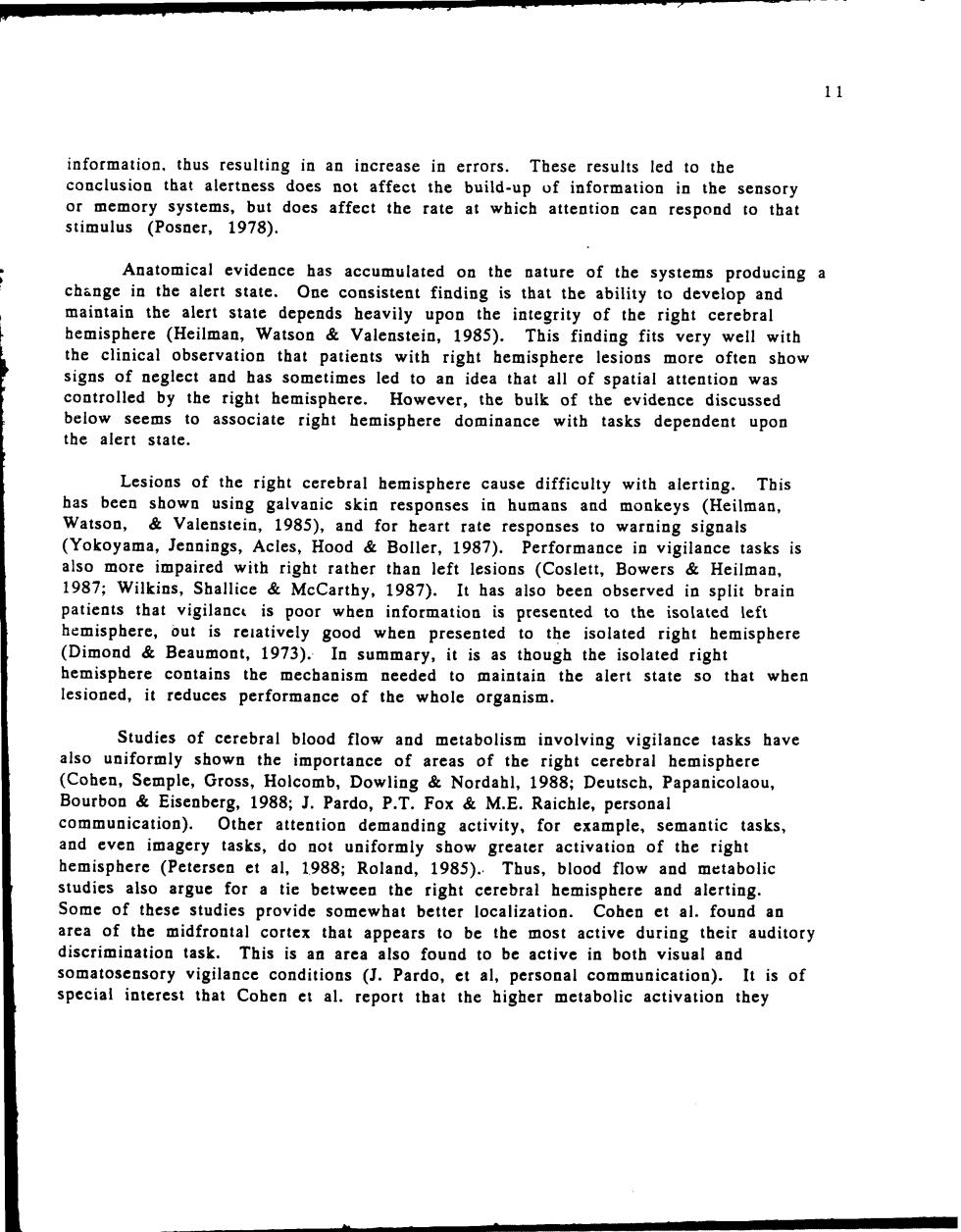正在加载图片...

11 information.thus resulting in an increase in errors.These results led to the conclusion that alertness does not affect the build-up of information in the sensory or memory systems,but does affect the rate at which attention can respond to that stimulus (Posner,1978) Anatomical evidence has accumulated on the nature of the systems producing a change in the alert state.One consistent finding is that the ability to develop and maintain the alert state depends heavily upon the integrity of the right cerebral hemisphere (Heilman,Watson Valenstein,1985).This finding fits very well with the clinical observation that patients with right hemisphere lesions more often show signs of neglect and has sometimes led to an idea that all of spatial attention was controlled by the right hemisphere.However,the bulk of the evidence discussed below seems to associate right hemisphere dominance with tasks dependent upo the alert state. Lesions of the right cerebral hemisphere cause difficulty with alerting This has been shown using galvanic skin ases in humans and Watson,Valenstein,1985).and for h eys (Heilman, res nses to (Yokovama.Jennings.Acles Ho 1987) also more impaired with i right 1g1 tasks is les 1987:Wilkins.Shallice (Coslett, Bowers 7 has also beet that in split brain igil poor wh te to the isolated left at is reiat dwhen Presented tothe isolated right bemisphere (Dimond Be cly good 973) In summary,it is as though the isolated right co tains the mechanism needed to maintain the alert state so that when lesioned,it reduces performance of the whole organism. Studies of cerebral blood flow and metabolism involving vigilance tasks have also uniformly shown the importance of areas of the right cerebral hemisphere (Cohen,Semple,Gross,Holcomb,Dowling Nordahl,1988;Deutsch,Papanicolaou, Bourbon Eisenberg,1988;J.Pardo,P.T.Fox M.E.Raichle,personal communication).Other attention demanding activity,for example,semantic tasks, and even imagery tasks,do not uniformly show greater activation of the right hemisphere (Petersen et al,1988:Roland.1985). Thus.blood flow and metabolic studies also argue for a tie between the right and alerting. Some of these studies p orovide some what b ter calizati en ct al.fo an area of the midfrontal cortex tha he 3 the auditory This is found activ somatosensory vigilanc special inte ons (J. .ct It is of est muai Coben ct al.report that the higher metabolic activation they 11 information, thus resulting in an increase in errors. These results led to the conclusion that alertness does not affect the build-up of information in the sensory or memory systems, but does affect the rate at which attention can respond to that stimulus (Posner, 1978). Anatomical evidence has accumulated on the nature of the systems producing a change in the alert state. One consistent finding is that the ability to develop and maintain the alert state depends heavily upon the integrity of the right cerebral hemisphere (Heilman, Watson & Valenstein, 1985). This finding fits very well with the clinical observation that patients with right hemisphere lesions more often show signs of neglect and has sometimes led to an idea that all of spatial attention was controlled by the right hemisphere. However, the bulk of the evidence discussed below seems to associate right hemisphere dominance with tasks dependent upon the alert state. Lesions of the right cerebral hemisphere cause difficulty with alerting. This has been shown using galvanic skin responses in humans and monkeys (Heilman, Watson, & Valenstein, 1985), and for heart rate responses to warning signals (Yokoyama, Jennings, Acles, Hood & Boiler, 1987). Performance in vigilance tasks is also more impaired with right rather than left lesions (Coslett, Bowers & Heilman, 1987; Wilkins, Shallice & McCarthy, 1987). It has also been observed in split brain patients that vigilanct is poor when information is presented to the isolated left hemisphere, out is reiatively good when presented to the isolated right hemisphere (Dimond & Beaumont, 1973). In summary, it is as though the isolated right hemisphere contains the mechanism needed to maintain the alert state so that when lesioned, it reduces performance of the whole organism. Studies of cerebral blood flow and metabolism involving vigilance tasks have also uniformly shown the importance of areas of the right cerebral hemisphere (Cohen, Semple, Gross, Holcomb, Dowling & Nordahl, 1988; Deutsch, Papanicolaou, Bourbon & Eisenberg, 1988; J. Pardo, P.T. Fox & M.E. Raichle, personal communication). Other attention demanding activity, for example, semantic tasks, and even imagery tasks, do not uniformly show greater activation of the right hemisphere (Petersen et al, 1988; Roland, 1985).. Thus, blood flow and metabolic studies also argue for a tie between the right cerebral hemisphere and alerting. Some of these studies provide somewhat better localization. Cohen et al. found an area of the midfrontal cortex that appears to be the most active during their auditory discrimination task. This is an area also found to be active in both visual and somatosensory vigilance conditions (J. Pardo, et al, personal communication). It is of special interest that Cohen et al. report that the higher metabolic activation they